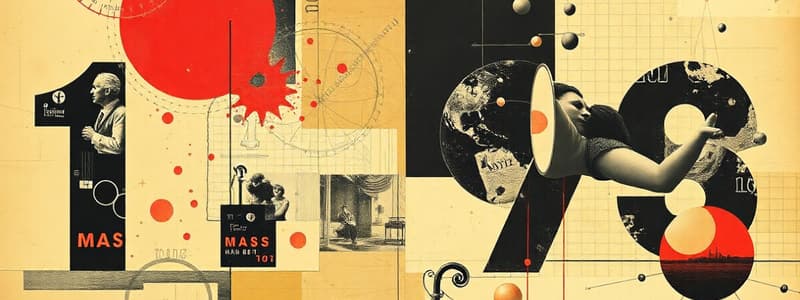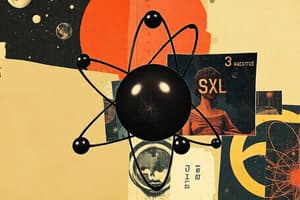Podcast
Questions and Answers
Explain how isotopes of an element can have different physical properties but similar chemical behaviors.
Explain how isotopes of an element can have different physical properties but similar chemical behaviors.
Isotopes have different numbers of neutrons, affecting their mass and physical properties. However, chemical behavior is primarily determined by the number of protons and electrons, which are the same for all isotopes of an element.
Describe the relationship between atomic number, mass number, and the number of neutrons in an atom.
Describe the relationship between atomic number, mass number, and the number of neutrons in an atom.
The mass number is the sum of the number of protons and neutrons in an atom's nucleus. The atomic number is the number of protons. Therefore, the number of neutrons equals the mass number minus the atomic number.
Explain why the atomic mass reported on the periodic table is usually not a whole number.
Explain why the atomic mass reported on the periodic table is usually not a whole number.
The atomic mass is a weighted average of the masses of all the naturally occurring isotopes of an element. Because isotopes have different masses and abundances, the average atomic mass is rarely a whole number.
If an atom has a mass number of 23 and contains 12 neutrons, what is its atomic number, and what element is it?
If an atom has a mass number of 23 and contains 12 neutrons, what is its atomic number, and what element is it?
What is the significance of knowing the number of protons in an atom?
What is the significance of knowing the number of protons in an atom?
Contrast the roles of protons, neutrons, and electrons in determining the chemical and physical properties of an atom.
Contrast the roles of protons, neutrons, and electrons in determining the chemical and physical properties of an atom.
Explain why the mass of an atom is concentrated in its nucleus.
Explain why the mass of an atom is concentrated in its nucleus.
How does the concept of isotopes explain the different forms of elements found in nature?
How does the concept of isotopes explain the different forms of elements found in nature?
Explain the difference between atomic mass and mass number, and why atomic mass is not a whole number.
Explain the difference between atomic mass and mass number, and why atomic mass is not a whole number.
Why is it not appropriate to use the term 'atomic weight' instead of 'atomic mass'?
Why is it not appropriate to use the term 'atomic weight' instead of 'atomic mass'?
Explain why isotopes of an element exhibit nearly identical chemical behavior.
Explain why isotopes of an element exhibit nearly identical chemical behavior.
Describe how the concept of atomic number is fundamental to the organization of the periodic table.
Describe how the concept of atomic number is fundamental to the organization of the periodic table.
What is the difference between Uranium-235 and Uranium-238, and why is this difference significant?
What is the difference between Uranium-235 and Uranium-238, and why is this difference significant?
Describe how to determine the number of electrons in an atom using the atomic number, considering both neutral atoms and ions.
Describe how to determine the number of electrons in an atom using the atomic number, considering both neutral atoms and ions.
If you have two isotopes of the same element, how would you differentiate them experimentally?
If you have two isotopes of the same element, how would you differentiate them experimentally?
Explain how the existence of isotopes supports the concept that atoms of the same element can have different masses.
Explain how the existence of isotopes supports the concept that atoms of the same element can have different masses.
If a neutral atom has 20 neutrons and a mass number of 41, identify the element and its group on the periodic table. Explain the reasoning.
If a neutral atom has 20 neutrons and a mass number of 41, identify the element and its group on the periodic table. Explain the reasoning.
Explain why the chemical properties of isotopes of hydrogen (protium, deuterium, and tritium) are more noticeably different than isotopes of other elements.
Explain why the chemical properties of isotopes of hydrogen (protium, deuterium, and tritium) are more noticeably different than isotopes of other elements.
How does the concept of 'charge unit' relate to the charges of electrons and protons?
How does the concept of 'charge unit' relate to the charges of electrons and protons?
Imagine two atoms, one with 8 protons and 8 neutrons, and the other with 8 protons and 9 neutrons. What are these atoms called, and how do their nuclear stabilities differ, if at all?
Imagine two atoms, one with 8 protons and 8 neutrons, and the other with 8 protons and 9 neutrons. What are these atoms called, and how do their nuclear stabilities differ, if at all?
Flashcards
Atomic Number (Z)
Atomic Number (Z)
Number of protons in an atom's nucleus; determines chemical identity.
Mass Number (A)
Mass Number (A)
Total count of protons and neutrons in an atom's nucleus.
Isotopes
Isotopes
Atoms with the same atomic number, but different mass numbers.
Electron
Electron
Signup and view all the flashcards
Proton
Proton
Signup and view all the flashcards
Neutron
Neutron
Signup and view all the flashcards
Study Notes
- Mass and Charge of Subatomic Particles are measured as follows:
- Electron mass is 9.10938 × 10^-28 g, charge is -1.6022 × 10^-19 Coulombs, charge unit is -1
- Proton mass is 1.67262 × 10^-24 g, charge is +1.6022 × 10^-19 Coulombs, charge unit is +1
- Neutron mass is 1.67493 × 10^-24 g, charge is 0 Coulombs, charge unit is 0
Atomic Number and Mass Number
- Atoms are identified by the number of protons and neutrons they contain.
- Atomic number (Z) refers to the number of protons in an element's nucleus.
- In a neutral atom, the number of protons equals the number of electrons and the atomic number indicates the number of electrons in the atom.
- The chemical identity of an atom is determined by its atomic number.
- For example, nitrogen's atomic number is 7, meaning each neutral nitrogen atom has 7 protons and 7 electrons.
- Mass number (A) is the total number of neutrons and protons in an atom's nucleus.
- All atomic nuclei contain both protons and neutrons, except for the most common form of hydrogen.
- Mass number = number of protons + number of neutrons = atomic number + number of neutrons
- The number of neutrons in an atom is equal to the difference between the mass number and the atomic number (A – Z).
- For example, if a boron atom has a mass number of 12 and an atomic number of 5, it has 7 neutrons (12 – 5 = 7).
- The atomic number, number of neutrons, and mass number must be positive integers, or whole numbers.
Isotopes
- Atoms of a given element do not all have the same mass.
- Isotopes are atoms with the same atomic number but different mass numbers.
- Hydrogen has three isotopes: hydrogen (one proton, no neutrons), deuterium (one proton, one neutron), and tritium (one proton, two neutrons).
- Mass number is written as a superscript to the left of the element symbol, and the atomic number as a subscript to the left of the element symbol.
Isotopes of Hydrogen and Uranium
- Isotopes of hydrogen are hydrogen (¹₁H), deuterium (²₁H), and tritium (³₁H).
- Isotopes of uranium are uranium-235 (²³⁵₉₂U) and uranium-238 (²³⁸₉₂U).
- Uranium-235 is used in nuclear reactors and atomic bombs.
- Isotopes of elements other than hydrogen are identified by their mass numbers.
- Chemical properties of an element are determined primarily by the protons and electrons in its atoms.
- Neutrons do not take part in chemical changes under normal conditions.
- Isotopes of the same element have similar chemistries, forming the same types of compounds and displaying similar reactivities.
Studying That Suits You
Use AI to generate personalized quizzes and flashcards to suit your learning preferences.




